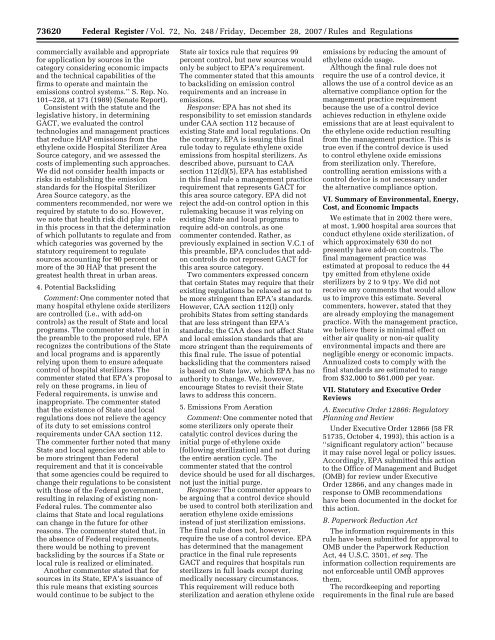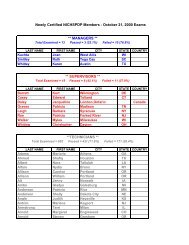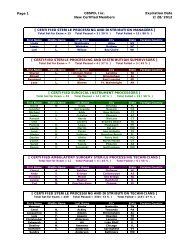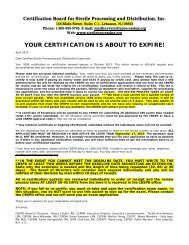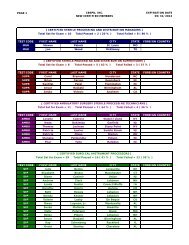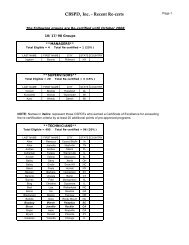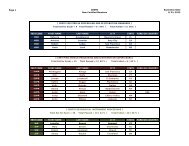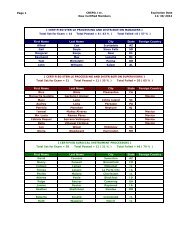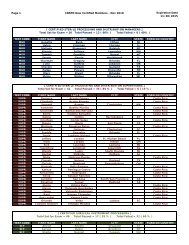Hospitals: Ethylene Oxide Sterilizers - US Environmental Protection ...
Hospitals: Ethylene Oxide Sterilizers - US Environmental Protection ...
Hospitals: Ethylene Oxide Sterilizers - US Environmental Protection ...
You also want an ePaper? Increase the reach of your titles
YUMPU automatically turns print PDFs into web optimized ePapers that Google loves.
73620 Federal Register / Vol. 72, No. 248 / Friday, December 28, 2007 / Rules and Regulationspwalker on PROD1PC71 with RULEScommercially available and appropriatefor application by sources in thecategory considering economic impactsand the technical capabilities of thefirms to operate and maintain theemissions control systems.’’ S. Rep. No.101–228, at 171 (1989) (Senate Report).Consistent with the statute and thelegislative history, in determiningGACT, we evaluated the controltechnologies and management practicesthat reduce HAP emissions from theethylene oxide Hospital Sterilizer AreaSource category, and we assessed thecosts of implementing such approaches.We did not consider health impacts orrisks in establishing the emissionstandards for the Hospital SterilizerArea Source category, as thecommenters recommended, nor were werequired by statute to do so. However,we note that health risk did play a rolein this process in that the determinationof which pollutants to regulate and fromwhich categories was governed by thestatutory requirement to regulatesources accounting for 90 percent ormore of the 30 HAP that present thegreatest health threat in urban areas.4. Potential BackslidingComment: One commenter noted thatmany hospital ethylene oxide sterilizersare controlled (i.e., with add-oncontrols) as the result of State and localprograms. The commenter stated that inthe preamble to the proposed rule, EPArecognizes the contributions of the Stateand local programs and is apparentlyrelying upon them to ensure adequatecontrol of hospital sterilizers. Thecommenter stated that EPA’s proposal torely on these programs, in lieu ofFederal requirements, is unwise andinappropriate. The commenter statedthat the existence of State and localregulations does not relieve the agencyof its duty to set emissions controlrequirements under CAA section 112.The commenter further noted that manyState and local agencies are not able tobe more stringent than Federalrequirement and that it is conceivablethat some agencies could be required tochange their regulations to be consistentwith those of the Federal government,resulting in relaxing of existing non-Federal rules. The commenter alsoclaims that State and local regulationscan change in the future for otherreasons. The commenter stated that, inthe absence of Federal requirements,there would be nothing to preventbacksliding by the sources if a State orlocal rule is realized or eliminated.Another commenter stated that forsources in its State, EPA’s issuance ofthis rule means that existing sourceswould continue to be subject to theState air toxics rule that requires 99percent control, but new sources wouldonly be subject to EPA’s requirement.The commenter stated that this amountsto backsliding on emission controlrequirements and an increase inemissions.Response: EPA has not shed itsresponsibility to set emission standardsunder CAA section 112 because ofexisting State and local regulations. Onthe contrary, EPA is issuing this finalrule today to regulate ethylene oxideemissions from hospital sterilizers. Asdescribed above, pursuant to CAAsection 112(d)(5), EPA has establishedin this final rule a management practicerequirement that represents GACT forthis area source category. EPA did notreject the add-on control option in thisrulemaking because it was relying onexisting State and local programs torequire add-on controls, as onecommenter contended. Rather, aspreviously explained in section V.C.1 ofthis preamble, EPA concludes that addoncontrols do not represent GACT forthis area source category.Two commenters expressed concernthat certain States may require that theirexisting regulations be relaxed as not tobe more stringent than EPA’s standards.However, CAA section 112(l) onlyprohibits States from setting standardsthat are less stringent than EPA’sstandards; the CAA does not affect Stateand local emission standards that aremore stringent than the requirements ofthis final rule. The issue of potentialbacksliding that the commenters raisedis based on State law, which EPA has noauthority to change. We, however,encourage States to revisit their Statelaws to address this concern.5. Emissions From AerationComment: One commenter noted thatsome sterilizers only operate theircatalytic control devices during theinitial purge of ethylene oxide(following sterilization) and not duringthe entire aeration cycle. Thecommenter stated that the controldevice should be used for all discharges,not just the initial purge.Response: The commenter appears tobe arguing that a control device shouldbe used to control both sterilization andaeration ethylene oxide emissionsinstead of just sterilization emissions.The final rule does not, however,require the use of a control device. EPAhas determined that the managementpractice in the final rule representsGACT and requires that hospitals runsterilizers in full loads except duringmedically necessary circumstances.This requirement will reduce bothsterilization and aeration ethylene oxideVerDate Aug2005 23:53 Dec 27, 2007 Jkt 214001 PO 00000 Frm 00048 Fmt 4700 Sfmt 4700 E:\FR\FM\28DER1.SGM 28DER1emissions by reducing the amount ofethylene oxide usage.Although the final rule does notrequire the use of a control device, itallows the use of a control device as analternative compliance option for themanagement practice requirementbecause the use of a control deviceachieves reduction in ethylene oxideemissions that are at least equivalent tothe ethylene oxide reduction resultingfrom the management practice. This istrue even if the control device is usedto control ethylene oxide emissionsfrom sterilization only. Therefore,controlling aeration emissions with acontrol device is not necessary underthe alternative compliance option.VI. Summary of <strong>Environmental</strong>, Energy,Cost, and Economic ImpactsWe estimate that in 2002 there were,at most, 1,900 hospital area sources thatconduct ethylene oxide sterilization, ofwhich approximately 630 do notpresently have add-on controls. Thefinal management practice wasestimated at proposal to reduce the 44tpy emitted from ethylene oxidesterilizers by 2 to 9 tpy. We did notreceive any comments that would allowus to improve this estimate. Severalcommenters, however, stated that theyare already employing the managementpractice. With the management practice,we believe there is minimal effect oneither air quality or non-air qualityenvironmental impacts and there arenegligible energy or economic impacts.Annualized costs to comply with thefinal standards are estimated to rangefrom $32,000 to $61,000 per year.VII. Statutory and Executive OrderReviewsA. Executive Order 12866: RegulatoryPlanning and ReviewUnder Executive Order 12866 (58 FR51735, October 4, 1993), this action is a‘‘significant regulatory action’’ becauseit may raise novel legal or policy issues.Accordingly, EPA submitted this actionto the Office of Management and Budget(OMB) for review under ExecutiveOrder 12866, and any changes made inresponse to OMB recommendationshave been documented in the docket forthis action.B. Paperwork Reduction ActThe information requirements in thisrule have been submitted for approval toOMB under the Paperwork ReductionAct, 44 U.S.C. 3501, et seq. Theinformation collection requirements arenot enforceable until OMB approvesthem.The recordkeeping and reportingrequirements in the final rule are based


